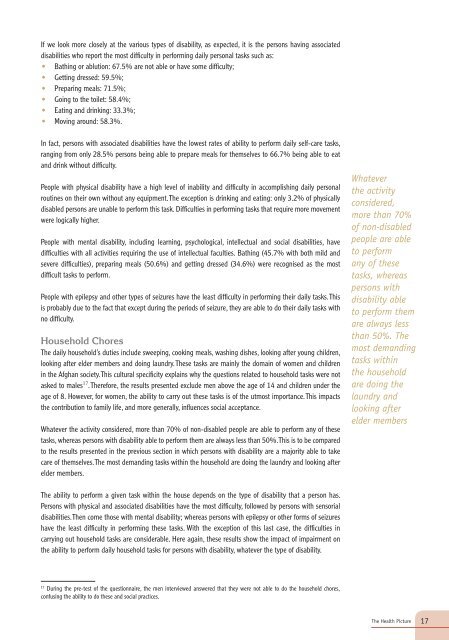Handicap International experience in Afghanistan - CBM
Handicap International experience in Afghanistan - CBM
Handicap International experience in Afghanistan - CBM
- No tags were found...
Create successful ePaper yourself
Turn your PDF publications into a flip-book with our unique Google optimized e-Paper software.
If we look more closely at the various types of disability, as expected, it is the persons hav<strong>in</strong>g associateddisabilities who report the most difficulty <strong>in</strong> perform<strong>in</strong>g daily personal tasks such as:• Bath<strong>in</strong>g or ablution: 67.5% are not able or have some difficulty;• Gett<strong>in</strong>g dressed: 59.5%;• Prepar<strong>in</strong>g meals: 71.5%;• Go<strong>in</strong>g to the toilet: 58.4%;• Eat<strong>in</strong>g and dr<strong>in</strong>k<strong>in</strong>g: 33.3%;• Mov<strong>in</strong>g around: 58.3%.In fact, persons with associated disabilities have the lowest rates of ability to perform daily self-care tasks,rang<strong>in</strong>g from only 28.5% persons be<strong>in</strong>g able to prepare meals for themselves to 66.7% be<strong>in</strong>g able to eatand dr<strong>in</strong>k without difficulty.People with physical disability have a high level of <strong>in</strong>ability and difficulty <strong>in</strong> accomplish<strong>in</strong>g daily personalrout<strong>in</strong>es on their own without any equipment. The exception is dr<strong>in</strong>k<strong>in</strong>g and eat<strong>in</strong>g: only 3.2% of physicallydisabled persons are unable to perform this task. Difficulties <strong>in</strong> perform<strong>in</strong>g tasks that require more movementwere logically higher.People with mental disability, <strong>in</strong>clud<strong>in</strong>g learn<strong>in</strong>g, psychological, <strong>in</strong>tellectual and social disabilities, havedifficulties with all activities requir<strong>in</strong>g the use of <strong>in</strong>tellectual faculties. Bath<strong>in</strong>g (45.7% with both mild andsevere difficulties), prepar<strong>in</strong>g meals (50.6%) and gett<strong>in</strong>g dressed (34.6%) were recognised as the mostdifficult tasks to perform.People with epilepsy and other types of seizures have the least difficulty <strong>in</strong> perform<strong>in</strong>g their daily tasks. Thisis probably due to the fact that except dur<strong>in</strong>g the periods of seizure, they are able to do their daily tasks withno difficulty.Household ChoresThe daily household’s duties <strong>in</strong>clude sweep<strong>in</strong>g, cook<strong>in</strong>g meals, wash<strong>in</strong>g dishes, look<strong>in</strong>g after young children,look<strong>in</strong>g after elder members and do<strong>in</strong>g laundry. These tasks are ma<strong>in</strong>ly the doma<strong>in</strong> of women and children<strong>in</strong> the Afghan society. This cultural specificity expla<strong>in</strong>s why the questions related to household tasks were notasked to males 17 . Therefore, the results presented exclude men above the age of 14 and children under theage of 8. However, for women, the ability to carry out these tasks is of the utmost importance. This impactsthe contribution to family life, and more generally, <strong>in</strong>fluences social acceptance.Whatever the activity considered, more than 70% of non-disabled people are able to perform any of thesetasks, whereas persons with disability able to perform them are always less than 50%. This is to be comparedto the results presented <strong>in</strong> the previous section <strong>in</strong> which persons with disability are a majority able to takecare of themselves. The most demand<strong>in</strong>g tasks with<strong>in</strong> the household are do<strong>in</strong>g the laundry and look<strong>in</strong>g afterelder members.Whateverthe activityconsidered,more than 70%of non-disabledpeople are ableto performany of thesetasks, whereaspersons withdisability ableto perform themare always lessthan 50%. Themost demand<strong>in</strong>gtasks with<strong>in</strong>the householdare do<strong>in</strong>g thelaundry andlook<strong>in</strong>g afterelder membersThe ability to perform a given task with<strong>in</strong> the house depends on the type of disability that a person has.Persons with physical and associated disabilities have the most difficulty, followed by persons with sensorialdisabilities. Then come those with mental disability; whereas persons with epilepsy or other forms of seizureshave the least difficulty <strong>in</strong> perform<strong>in</strong>g these tasks. With the exception of this last case, the difficulties <strong>in</strong>carry<strong>in</strong>g out household tasks are considerable. Here aga<strong>in</strong>, these results show the impact of impairment onthe ability to perform daily household tasks for persons with disability, whatever the type of disability.17Dur<strong>in</strong>g the pre-test of the questionnaire, the men <strong>in</strong>terviewed answered that they were not able to do the household chores,confus<strong>in</strong>g the ability to do these and social practices.The Health Picture17
















